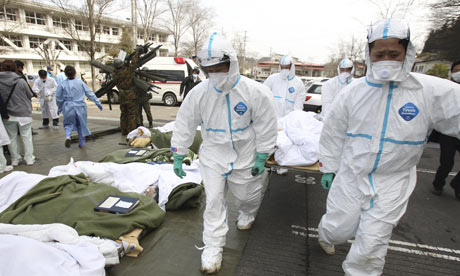 Within just a few days, the media reports on the earthquake in Japan are now dominated by the nuclear disaster that occurred in Fukushima. Almost everyone who saw images on TV or newspapers will have been shocked… Personally it reminded me of the disaster images displayed in the Japanese Hiroshima Museum: deserted streets, ruins, clouds of smoke. Now, street cops are dressed in white radiation suits and wearing respirators. At least half a million people must be evacuated from the blasting zone.
Within just a few days, the media reports on the earthquake in Japan are now dominated by the nuclear disaster that occurred in Fukushima. Almost everyone who saw images on TV or newspapers will have been shocked… Personally it reminded me of the disaster images displayed in the Japanese Hiroshima Museum: deserted streets, ruins, clouds of smoke. Now, street cops are dressed in white radiation suits and wearing respirators. At least half a million people must be evacuated from the blasting zone.
What is going on in the psyche of many Japanese, who now for the second time in less than 70 years experience a nuclear disaster on their islands, can hardly be imagined. Japan has turned nuclear energy into a force of peace and economic prosperity. This is one of the great postwar achievements of Japan, not only in a symbolic way but also in a very real sense. However, yet again has the ‘atom’ has turned into a scourge of the people – despite the fact that the Japanese nuclear power plants are among the ‘safest’ in the world.
To simply put away this secondary trauma will not be possible – a repeat of the shock experience breaks the last barriers even in the most stable minds. On the surface, most Japanese react as composed as usual – but one can assume that the disaster will have massive consequences. Even a move away from nuclear energy is possible in such circumstances, despite Japan now covering 20% of its energy needs by this source of energy. But in Fukushima, Man (once again) was demonstrated his limitations.
Will the catharsis of trauma ultimately lead to a massive research for alternative energy generation technologies? Japan could prove a germ cell for that as well – just as trauma patients can often finish a successful therapy stronger and more creative, than they were before the tragic event.
(This short article is part of a weekly series dealing with psychological expat problems and general mental health issues and was published in various newspapers and magazines in Thailand, 2011)


